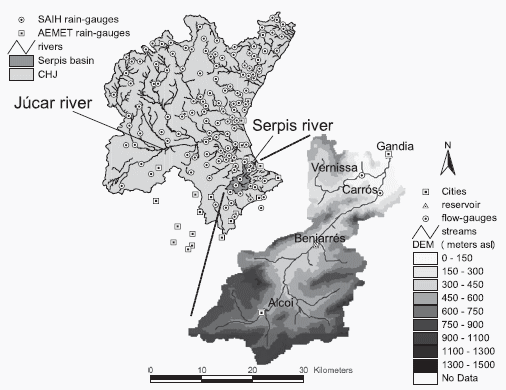A new paper has been published in Journal of Hydrometeorology and is now online.
Title: A Comparison of Ensemble Strategies for Flash Flood Forecasting: The 12 October 2007 Case Study in Valencia, Spain
Abstract: On 12 October 2007, several flash floods affected the
Valencia region, eastern Spain, with devastating impacts in terms
of human, social, and economic losses. An enhanced modeling
and forecasting of these extremes, which can provide a tangible
basis for flood early warning procedures and mitigation measures
over the Mediterranean, is one of the fundamental motivations of
the international Hydrological Cycle in the Mediterranean
Experiment (HyMeX) program. The predictability bounds set by
multiple sources of hydrological and meteorological uncertainty
require their explicit representation in hydrometeorological
forecasting systems. By including local convective precipitation
systems, short-range ensemble prediction systems (SREPSs) provide
a state-of-the-art framework to generate quantitative discharge
forecasts and to cope with different sources of external-scale
(i.e., external to the hydrological system) uncertainties.
The performance of three distinct hydrological ensemble
prediction systems (HEPSs) for the small-sized Serpis River
basin is examined as a support tool for early warning and
mitigation strategies. To this end, the Flash-Flood Event–Based
Spatially Distributed Rainfall–Runoff Transformation–Water Balance
(FEST-WB) model is driven by ground stations to examine the
hydrological response of this semiarid and karstic catchment
to heavy rains. The use of a multisite and novel calibration
approach for the FEST-WB parameters is necessary to cope with
the high nonlinearities emerging from the rainfall–runoff
transformation and heterogeneities in the basin response.
After calibration, FEST-WB reproduces with remarkable accuracy
the hydrological response to intense precipitation and,
in particular, the 12 October 2007 flash flood.
Next, the flood predictability challenge is focused on
quantitative precipitation forecasts (QPFs).
In this regard, three SREPS generation strategies using
the WRF Model are analyzed. On the one side, two SREPSs
accounting for 1) uncertainties in the initial conditions (ICs)
and lateral boundary conditions (LBCs) and 2) physical parameterizations
are evaluated. An ensemble Kalman filter (EnKF) is also designed to
test the ability of ensemble data assimilation methods to represent
key mesoscale uncertainties from both IC and subscale processes.
Results indicate that accounting for diversity in the physical
parameterization schemes provides the best probabilistic high-resolution
QPFs for this particular flash flood event. For low to moderate
precipitation rates, EnKF and pure multiple physics approaches
render undistinguishable accuracy for the test situation at larger scales.
However, only the multiple physics QPFs properly drive the HEPS to render
the most accurate flood warning signals. That is, extreme precipitation
values produced by these convective-scale precipitation systems anchored
by complex orography are better forecast when accounting just for
uncertainties in the physical parameterizations. These findings contribute
to the identification of ensemble strategies better targeted to the most
relevant sources of uncertainty before flash flood situations over small catchments.
![]() Flood forecast of the 12 October 2007 event in Valencia, Spain by Giovanni Ravazzani is licensed under a Creative Commons Attribution-NonCommercial 4.0 International License.
Flood forecast of the 12 October 2007 event in Valencia, Spain by Giovanni Ravazzani is licensed under a Creative Commons Attribution-NonCommercial 4.0 International License.
